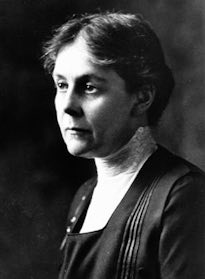Alice Hamilton chose medicine because “as a doctor I could go anywhere I pleased – to far-off lands or to city slums – and be quite sure I could be of use anywhere.”
She quickly discovered she felt more at home in the laboratory than at the bedside. Her first job, teaching pathology at Northwestern University, gave her the chance to realize her dream to live at Hull House. There, she came to know Jane Addams and other reformers
who encouraged her to find a way to apply her scientific knowledge to social problems.
Alice Hamilton began to investigate industrial diseases. She saw cases of lead palsy and carbon monoxide gassing among workers in the area. Because they were Poles, Italians, or African Americans, their fate had passed unnoticed. Industries denied responsibility, and states had no workmen’s compensation laws.
Dr. Hamilton conducted pioneering surveys of industrial disease, and found that European countries not only outdistanced the U.S. in research but also legislated sickness insurance programs.
She studied the poisons affecting workers in the lead, munitions, and copper industries, traveling the country and touring mines and factories, smelters and forges. Her reports were always meticulously fair and impartial.
In 1918, Alice Hamilton was appointed assistant professor of industrial medicine at the Harvard University School. She was the first and, for many years, the only woman on the Harvard faculty. Though she was treated shabbily, excluded from the faculty club and the commencement procession, her research continued to help promote safety in the American workplace.

